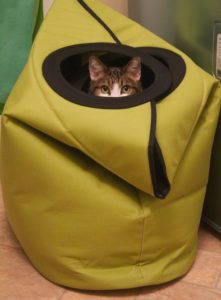 What does your cat do when she feels vulnerable? Many cats, when a stranger invades her space, there’s a loud noise (the trash truck picking up barrels in front of your house, a siren screaming past, the vacuum cleaner running over the carpet), will hide. They’ll seek out a dark closet in the back of the house, a cozy spot behind your computer, or under a bed. In our house, Sophie hides under a piece of furniture and Lily scrambles to where she feels most safe—under the covers.
What does your cat do when she feels vulnerable? Many cats, when a stranger invades her space, there’s a loud noise (the trash truck picking up barrels in front of your house, a siren screaming past, the vacuum cleaner running over the carpet), will hide. They’ll seek out a dark closet in the back of the house, a cozy spot behind your computer, or under a bed. In our house, Sophie hides under a piece of furniture and Lily scrambles to where she feels most safe—under the covers.
Cats also like to play or sleep inside enclosures on their cat tree, a tunnel or tent or a box.
Hiding is not uncommon behavior for a cat. I talked to an in-home physical therapist yesterday who remarked that my mother’s cat was the only one he’s met who doesn’t hide when he arrives for a therapy session. We certainly see traits in our house cats indicative of their wild ancestors and hiding or burrowing is quite natural in that context. While some cats bring with them a stronger instinct to hunt or to climb or to experience the out of doors, some are more inclined to run and hide when they feel threatened in any way.
 So it’s no wonder that the Thundershirt works to calm some cats during a thunder episode or fireworks display too close to home, for example. Pressure for calming is widely used among veterinarians and other animal practitioners on a wide variety of animals for various purposes. Cats feel secure in tight spaces. So it follows that the Thundershirt—designed to apply a comforting pressure around the torso of the cat can create a calming effect in times of stress. I should have thought of this when we had to evacuate during the fire in December. It’s probably something worth getting your cats accustomed to for unexpected storms or natural and unnatural disaster episodes. They only cost anywhere from $15 up to around $40.
So it’s no wonder that the Thundershirt works to calm some cats during a thunder episode or fireworks display too close to home, for example. Pressure for calming is widely used among veterinarians and other animal practitioners on a wide variety of animals for various purposes. Cats feel secure in tight spaces. So it follows that the Thundershirt—designed to apply a comforting pressure around the torso of the cat can create a calming effect in times of stress. I should have thought of this when we had to evacuate during the fire in December. It’s probably something worth getting your cats accustomed to for unexpected storms or natural and unnatural disaster episodes. They only cost anywhere from $15 up to around $40.
Have you used a Thundershirt for your cat or another form of pressure in times of stress? Tell us about it.





